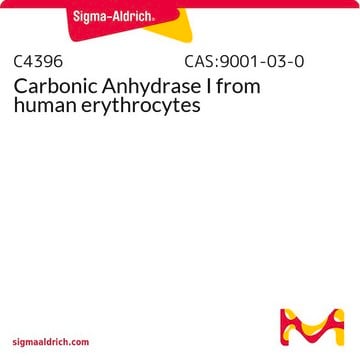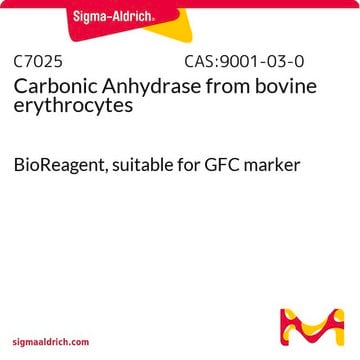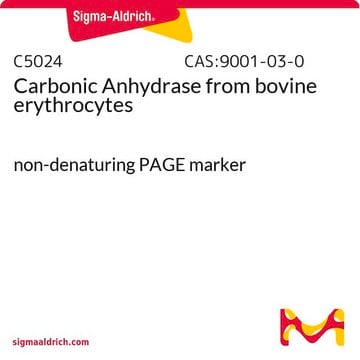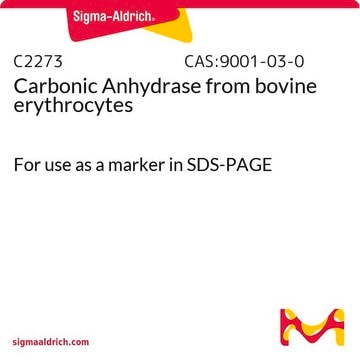C6165
Carbonic Anhydrase Isozyme II human
≥80%, powder, ≥3,000 W-A units/mg protein
Synonyme(s) :
Carbonate Dehydratase, Carbonate Hydrolyase
Se connecterpour consulter vos tarifs contractuels et ceux de votre entreprise/organisme
About This Item
Produits recommandés
Application
Human carbonic anhydrase isozyme II has been used to assess its gene fusion abilities for efficient expression and recovery of recombinant proteins. Human carbonic anhydrase isozyme II has also been used to investigate a new process for the synthesis of difluoromethanesulfonamides. Furthermore, CA II from Sigma has been used as a standard to measure the CA activity in lung tissue homogenates. The study analysed the possible relationship between the expression of carbonic anhydrase and non-small cell lung cancer. The product has also been used with Freund′s complete adjuvant at 1:1 ratio for antibody production. This study evaluated the quantitative and functional alterations of cytosolic CA isoenzymes in the erythrocytes of glucose-6-phosphate dehydrogenase (G6PD)-deficient individuals. The enzyme has also been used in the study of natural phenolic inhibitors of CA II.
Actions biochimiques/physiologiques
Carbonic anhydrase is a zinc metalloenzyme that catalyzes the hydration of carbon dioxide to carbonic acid. It is involved in pathological and physiological processes such as pH and CO2 homeostasis, transport of bicarbonate and CO2, biosynthetic reactions, bone resorption, calcification, and tumorigenicity. Therefore, this enzyme is an important target for inhibitors that can be used for treating various pathological conditions such as glaucoma, epilepsy and Parkinson′s disease. CAII has a molecular mass of approximately 30 kDa and is primarily present in type II pneumocytes. Due to this unique location it has been speculated that CAII is involved in pulmonary functions such as regulation of fluid secretion and CO2 elimation. Sulfonamides, sulfamates and sulfamides are potent inhibitors of CA.
Définition de l'unité
One Wilbur-Anderson (W-A) unit will cause the pH of a 0.02 M Trizma buffer to drop from 8.3 to 6.3 per min at 0 °C. (One W-A unit is essentially equivalent to one Roughton-Booth unit.)
Inhibiteur
Réf. du produit
Description
Tarif
Mention d'avertissement
Danger
Mentions de danger
Conseils de prudence
Classification des risques
Resp. Sens. 1
Code de la classe de stockage
11 - Combustible Solids
Classe de danger pour l'eau (WGK)
WGK 3
Point d'éclair (°F)
Not applicable
Point d'éclair (°C)
Not applicable
Certificats d'analyse (COA)
Recherchez un Certificats d'analyse (COA) en saisissant le numéro de lot du produit. Les numéros de lot figurent sur l'étiquette du produit après les mots "Lot" ou "Batch".
Déjà en possession de ce produit ?
Retrouvez la documentation relative aux produits que vous avez récemment achetés dans la Bibliothèque de documents.
Les clients ont également consulté
Shinya Tsukiji et al.
Methods in molecular biology (Clifton, N.J.), 1266, 243-263 (2015-01-07)
Introducing nongenetically encoded, synthetic probes into specific proteins is now recognized as a key component in chemical biology. In particular, the ability to chemically modify specific "native" proteins in various contexts from in vitro to cellular systems is of fundamental
Ghita Ghislat et al.
Biomolecules, 10(11) (2020-11-25)
Background and purpose: Identifying the macromolecular targets of drug molecules is a fundamental aspect of drug discovery and pharmacology. Several drugs remain without known targets (orphan) despite large-scale in silico and in vitro target prediction efforts. Ligand-centric chemical-similarity-based methods for
W L Chiang et al.
Clinica chimica acta; international journal of clinical chemistry, 314(1-2), 195-201 (2001-11-24)
This study was designed to evaluate the quantitative and activity alterations of cytosolic carbonic anhydrase (CA) isoenzymes in the erythrocytes of glucose-6-phosphate dehydrogenase (G6PD)-deficient individuals. Western Blot and CA esterase activity analysis were employed to measure cytosolic erythrocyte CA isoenzymes.
Screening and docking studies of natural phenolic inhibitors of carbonic anhydrase II
Huang HQ, et al.
Science in China. Series B, Chemistry, Life Sciences & Earth Sciences, 52(3), 332-337 (2009)
Scott K Parks et al.
Nature reviews. Cancer, 13(9), 611-623 (2013-08-24)
Intense interest in the 'Warburg effect' has been revived by the discovery that hypoxia-inducible factor 1 (HIF1) reprogrammes pyruvate oxidation to lactic acid conversion; lactic acid is the end product of fermentative glycolysis. The most aggressive and invasive cancers, which
Protocoles
Enzymatic Assay of Carbonic Anhydrase for Wilbur-Anderson Units (EC 4.2.1.1)
Notre équipe de scientifiques dispose d'une expérience dans tous les secteurs de la recherche, notamment en sciences de la vie, science des matériaux, synthèse chimique, chromatographie, analyse et dans de nombreux autres domaines..
Contacter notre Service technique















